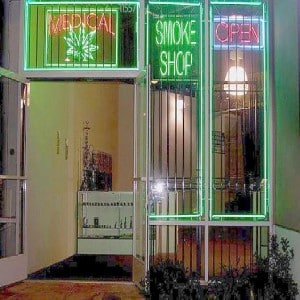As cities across California struggle with how to handle medical marijuana dispensaries and police agencies blame them for an increase in lawlessness, academics are delving into data to find out whether pot shops really do influence neighborhood crime.
Bridget Freisthler, an associate professor of social welfare at UCLA’s Luskin School of Public Affairs, has turned up some surprising findings. In her research, she’s found that the hundreds of pot dispensaries operating in the city of Los Angeles are clustered in better-off places, like beachside Venice, Hollywood and Westwood, but are notably sparse in places like South Los Angeles.
Worried about crime? Well, you’re better off within 100 feet of a dispensary than a liquor store, bar or even a restaurant, according to a 2007 study Freisthler conducted with UCLA social welfare doctoral student Nancy Williams that compared average crime rates.
But Freisthler’s not satisfied with her results – they’re snapshots in time, she said, and require further study, which she began this year. Freisthler received a $2.7 million National Institutes of Health grant this September for further research on Los Angeles and Sacramento in what is believed to be the first study of how dispensaries influence crime rates over an extended period of time.
Studies that present early conclusions, such as a recent RAND study that examined crime rates over a 20-day period, don’t use enough data to back up their results, Freisthler said.
The RAND study, which asserts that closing dispensaries in Los Angeles increases local crime rates, only looked at the 10 days before and after certain dispensaries were required by the city to close, a time period too short to make that sweeping claim, Freisthler said – never mind the glaring oversight of failing to confirm that those dispensaries actually closed, she added.
“Their study methods are flawed,” she said.
Freisthler pointed out that the RAND study not only drew conclusions from a small sample over a short time period, but it also assumed that the dispensaries were closed at random, without controlling for possible reasons why the city may have targeted those collectives.
“It’s a much more complicated picture, which a lot of people are studying,” she said. “It’s premature for anyone to say anything definitive.”
That said, Freisthler is intrigued by what some early studies, including her own, have revealed. A 2010 study she conducted suggests marked differences between neighborhoods with dispensaries in Los Angeles and Sacramento. In Los Angeles, census tracts with dispensaries have larger white populations, higher education levels, and lower poverty and unemployment rates than census tracts without pot clubs.
“In Sacramento, it’s almost the opposite. That’s why it’s so hard for anyone to generalize at this point,” she said.
In Sacramento, unemployment and poverty rates were actually higher in census tracts with dispensaries, while the differences in white populations and education levels were not statistically significant.
“It looks like the data differs very much from city to city and probably by how laws concerning dispensaries are enforced,” Freisthler said.
The Los Angeles demographic findings mirror maps showing a relative paucity of dispensaries in places like South Los Angeles, she said.
 “I suspect what’s going on, although we don’t know for sure, is that those areas that already had a strong illegal drug market aren’t really seeing a lot of dispensaries because access to marijuana is already easy,” she said. “The dispensaries are finding a market among people who aren’t willing to buy on the street. Whether people in charge of the drug markets in dispensary-free areas are actively trying to keep the dispensaries out, I don’t know.”
“I suspect what’s going on, although we don’t know for sure, is that those areas that already had a strong illegal drug market aren’t really seeing a lot of dispensaries because access to marijuana is already easy,” she said. “The dispensaries are finding a market among people who aren’t willing to buy on the street. Whether people in charge of the drug markets in dispensary-free areas are actively trying to keep the dispensaries out, I don’t know.”
As Freisthler builds a longitudinal database to look at extended periods of time in different cities, she’ll compare whether some early findings in Sacramento also hold true in Los Angeles.
In a 2010 study of Sacramento’s 31 dispensaries, she found that those with security cameras, guards or doormen, or those with signs announcing that buyers needed a medical marijuana card, had lower crime rates within 250 feet than cannabis collectives without those features. However, the differences dropped away rapidly; within 500 feet, they vanished.
“It makes sense that with things like security cameras you would see a very localized crime-deterrent effect,” Freisthler theorized.
The RAND study looked at distances of three-tenths of a mile and six-tenths of a mile, or about 1,600 and 3,200 feet – distances Freisthler says are probably too great for any significant effects to be seen.
“So ‘dispensaries have less crime when they’re open’ is a nice headline, but it’s missing so much,” she said. “There are a whole bunch of interesting findings that shed more light on what’s going on in this area than just that quick snapshot.”
For more news, visit the UCLA Newsroom







